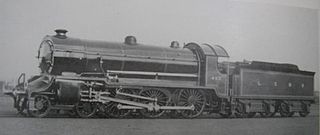
The LSWR/SR H15 class was a class of 2-cylinder 4-6-0 steam locomotives designed by Robert Urie for mixed-traffic duties on the LSWR. Further batches were constructed by Richard Maunsell for the Southern Railway after 1923. They were given the nickname of "Junior King Arthur" due to the size of their driving wheels, the S15 and their N15 cousins had driving wheels which had a diameter of 5 foot and 7 inches and 6 foot and 7 inches respectively.

The LSWR N15 class was a British 2–cylinder 4-6-0 express passenger steam locomotive designed by Robert Urie. The class has a complex build history spanning three sub-classes and ten years of construction from 1918 to 1927. The first batch of the class was constructed for the London and South Western Railway (LSWR), where they hauled heavy express passenger trains to the south coast ports and further west to Exeter. After the Lord Nelsons, they were the second biggest 4-6-0 passenger locomotives on the Southern Railway. They could reach speeds of up to 90 mph (145 km/h).

The SR V class, more commonly known as the Schools class, is a class of steam locomotive designed by Richard Maunsell for the Southern Railway. The class was a cut down version of his Lord Nelson class but also incorporated components from Urie and Maunsell's LSWR/SR King Arthur class. It was the last locomotive in Britain to be designed with a 4-4-0 wheel arrangement, and was the most powerful class of 4-4-0 ever produced in Europe. All 40 of the class were named after English public schools, and were designed to provide a powerful class of intermediate express passenger locomotive on semi-fast services for lines which could cope with high axle loads but some of which had short turntables.
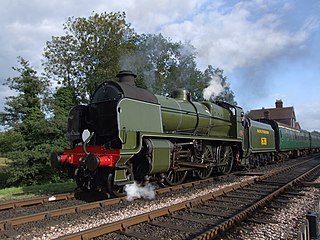
The SR U class are 2-6-0 steam locomotives designed by Richard Maunsell for passenger duties on the Southern Railway (SR). The class represented the penultimate stage in the development of the Southern Railway's 2-6-0 "family", which improved upon the basic principles established by GWR Chief Mechanical Engineer (CME) George Jackson Churchward for Great Western Railway (GWR) locomotives. The U class design drew from experience with the GWR 4300s and N classes, improved by applying Midland Railway ideas to the design, enabling the SECR to influence development of the 2-6-0 in Britain.

The LSWR M7 class is a class of 0-4-4T passenger tank locomotive built between 1897 and 1911. The class was designed by Dugald Drummond for use on the intensive London network of the London and South Western Railway (LSWR), and performed well in such tasks. Because of their utility, 105 were built and the class went through several modifications over five production batches. For this reason there were detail variations such as frame length. Many of the class were fitted with push-pull operation gear that enabled efficient use on branch line duties without the need to change to the other end of its train at the end of a journey.

The LSWR S15 class is a British 2-cylinder 4-6-0 freight steam locomotive designed by Robert W. Urie, based on his H15 class and N15 class locomotives. The class had a complex build history, spanning several years of construction from 1920 to 1936. The first examples were constructed for the London and South Western Railway (LSWR), where they hauled freight trains to the south coast ports and further west to Exeter, as well as occasional passenger work in conjunction with their larger-wheeled N15 class counterparts.

Dugald Drummond was a Scottish steam locomotive engineer. He had a career with the North British Railway, LB&SCR, Caledonian Railway and London and South Western Railway. He was the older brother of the engineer Peter Drummond, who often followed Dugald's ideas in his own work.

The Q Class is a type of 0-6-0 steam locomotive designed by Richard Maunsell of the Southern Railway and constructed immediately prior to the Second World War for use on medium-distance freight trains throughout the network. Twenty locomotives were built by Maunsell's successor, Oliver Bulleid, in 1938. The design was relatively old-fashioned and the class was soon afterwards eclipsed by Bulleid's own more powerful Q1 class. Nevertheless the locomotives performed adequately and reliably on the tasks for which they had been designed, until their withdrawal in 1965. Only one has survived, and is preserved on the Bluebell Railway.

The London and South Western Railway L11 class was a class of 4-4-0 steam locomotives designed for mixed traffic work. They were introduced in 1903 and were nicknamed "Large Hoppers". As with most other Drummond productions, the locomotive had two inside cylinders and Stephenson link valve gear.

The London and South Western Railway K10 Class was a class of 40 4-4-0 steam locomotives designed for mixed traffic work. They were introduced on the London and South Western Railway in 1901 and 1902 to the design of Dugald Drummond, where they earned the nickname "Small Hoppers".

The SECR N class was a type of 2-6-0 ("mogul") steam locomotive designed in 1914 by Richard Maunsell for mixed-traffic duties on the South Eastern and Chatham Railway (SECR). Built between 1917 and 1934, it was the first non-Great Western Railway (GWR) type to use and improve upon the basic design principles established by GWR Chief Mechanical Engineer (CME) George Jackson Churchward. The N class was based on the GWR 4300 Class design, improved with Midland Railway concepts.
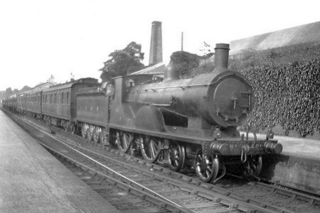
The London and South Western Railway T9 class is a class of 66 4-4-0 steam locomotive designed for express passenger work by Dugald Drummond and introduced to services on the LSWR in 1899. One example has been preserved after British Railways ownership. They were given the nickname of "Greyhounds" due to their speed, up to 85 miles per hour (137 km/h), and reliability.
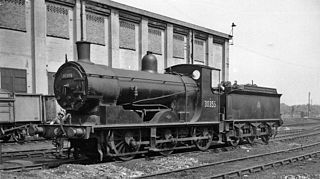
The LSWR 700 class was a class of 30 0-6-0 steam locomotives designed for freight work. The class was designed by Dugald Drummond in 1897 for the London and South Western Railway in England and built by Dübs and Company at that company's Queen's Park works at Polmadie, Glasgow, Scotland.

The LSWR Class S11 was a class of 10 4-4-0 steam locomotives designed for express passenger work by Dugald Drummond. They were introduced to services on the London and South Western Railway in 1903. None of the class survived into preservation after their brief career in British Railways ownership.

The London and South Western Railway F13 class was a class of 4-6-0 locomotives designed by Dugald Drummond for the London and South Western Railway (LSWR).

The LSWR Class T14 was a class of ten 4-6-0 locomotives designed by Dugald Drummond for express passenger use on the London and South Western Railway and constructed at Eastleigh in 1911–12.

The LSWR E14 Class was a class of 4-6-0 locomotive designed by Dugald Drummond for the London and South Western Railway.

The LSWR G14 class was a class of 4-6-0 locomotive designed by Dugald Drummond for the London and South Western Railway.
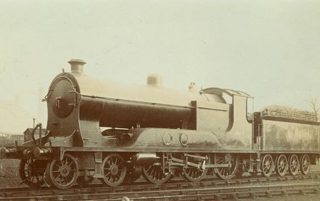
The LSWR P14 class was a class of 4-6-0 locomotive designed by Dugald Drummond for the London and South Western Railway.

The LSWR D15 class 4-4-0 was the last steam locomotive design by Dugald Drummond for the London and South Western Railway in 1912. By 1912, Dugald Drummond had built several classes of unsuccessful 4-6-0 express passenger locomotives. The result of these failures was that when he designed what was to be his last class in 1911, a new 4-4-0 design emerged from Eastleigh Works in February 1912, with what was to be the first of his D15 class.






















